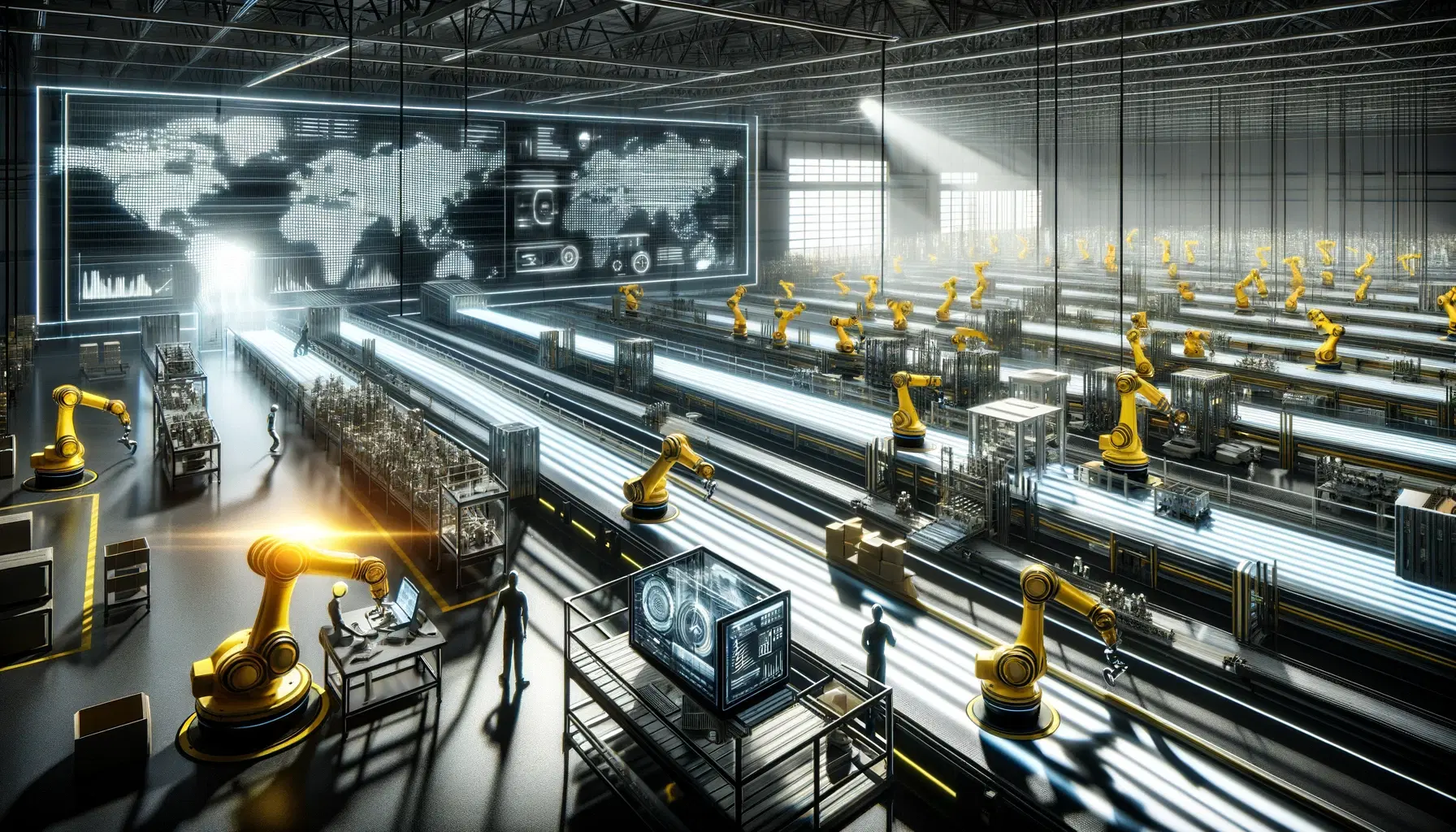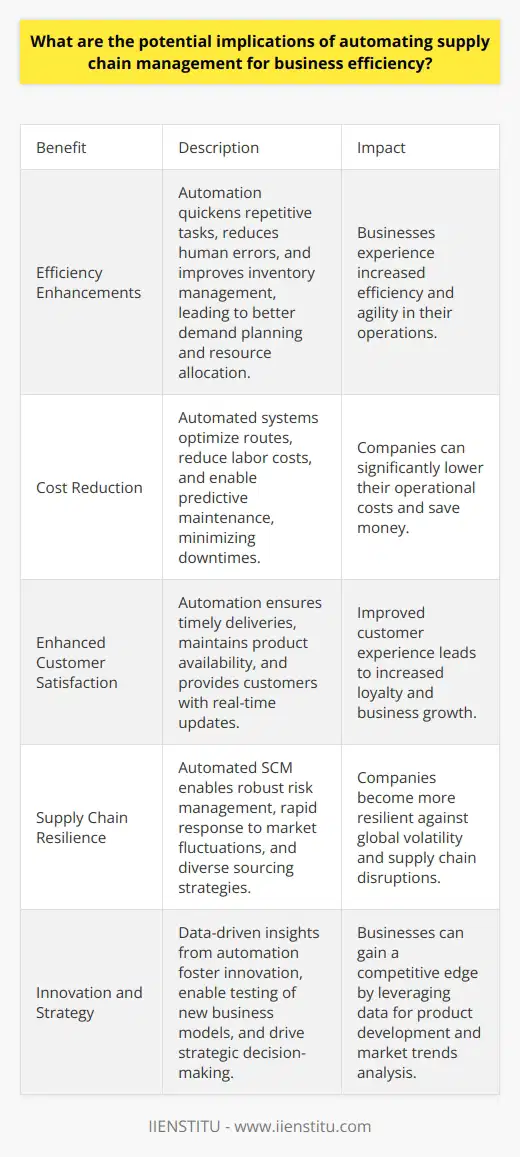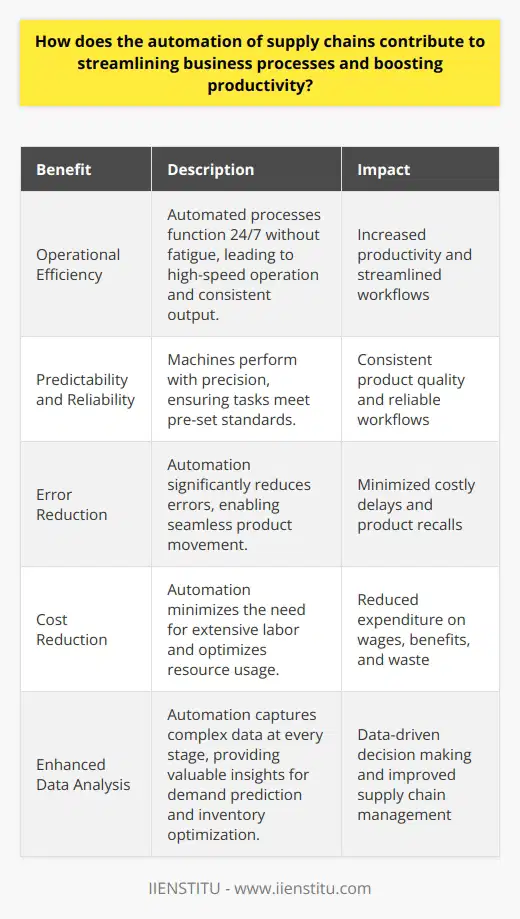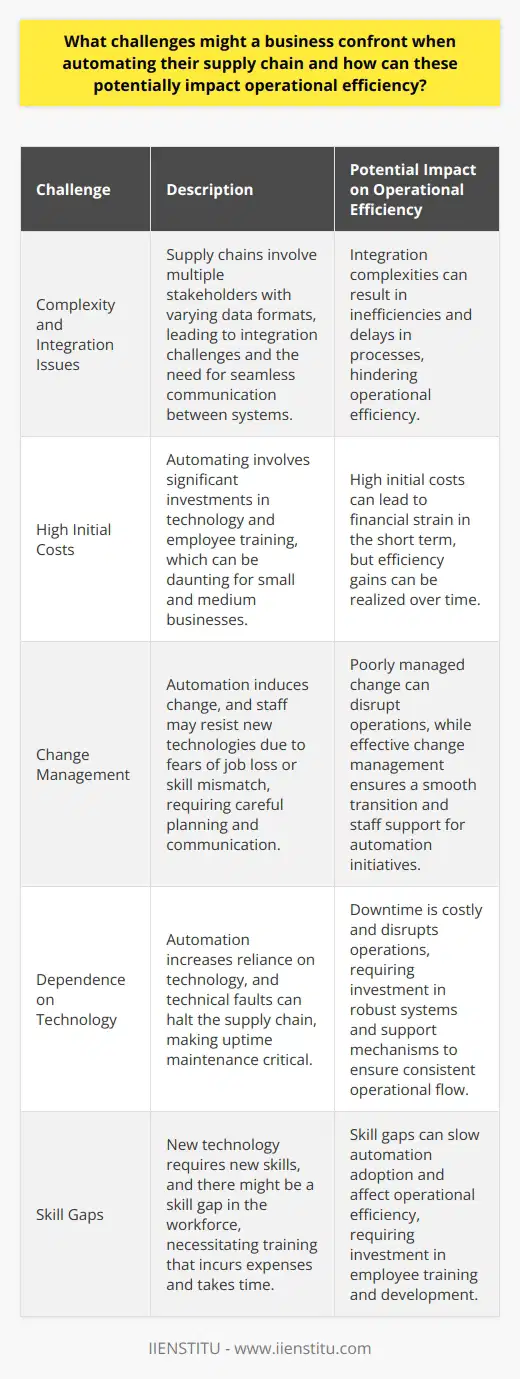
In a rapidly evolving business landscape, marked by escalating customer demands and the relentless pursuit of operational excellence, the concept of supply chain automation has emerged as a pivotal factor in redefining the efficiency of business operations. Supply chain automation refers to the use of technology to perform tasks without human intervention within the various components of the supply chain, including procurement, manufacturing, warehousing, and transportation.
Its significance lies in its power to streamline processes, reduce manual errors, and accelerate responsiveness to market changes. This article will explore the multifaceted aspects of supply chain automation, its evolution, and its profound implications for modern businesses.
Evolution of Supply Chain Automation
Traditional Manual Supply Chain Management: The traditional model of supply chain management relied heavily on manual processes and the human touch. Logistics teams were inundated with paper-based tasks, from managing inventory to arranging shipments, every step necessitated hands-on attention. Communication was slower and error-prone, hindering the ability to react swiftly to market fluctuations or consumer demands. This approach, while rich in personal interactions, was not scalable in today's fast-paced economy.
Introduction of Technology in Supply Chain Management: The genesis of technology within supply chain management was a turning point, signifying the initial steps toward automation. Technologies such as Electronic Data Interchange (EDI) and basic inventory management systems began to chip away at the mountain of manual processes. These technologies offered a glimpse into a future where data could be communicated faster and operations could be streamlined, setting the stage for a more efficient, although still rudimentary, supply chain environment.
Advancement and Rise of Automation in Supply Chain Management: As technology advanced, so too did the scope and efficacy of supply chain automation. Software platforms evolved from simple inventory tracking to comprehensive systems that could anticipate demand, optimize routes, and manage complex cross-border logistics. The entrance of the Internet of Things (IoT), artificial intelligence (AI), and robotics transformed supply chains into sophisticated networks capable of unprecedented efficiency and speed.
Example of a Company that has made Significant Changes Over Time in Their Supply Chain Management: A prime example of a company that has significantly revamped its supply chain through automation is Amazon. From pioneering online order processing to utilizing robotic fulfillment, Amazon's adoption of automation technologies has been instrumental in enabling its rapid growth and customer service excellence.
Importance of Supply Chain Automation
Increase in Operational Efficiency: The deployment of automation within supply chains has been central to the dramatic increase in operational efficiency for businesses of all sizes. Automated systems can process vast amounts of information rapidly, leading to quicker decision-making and a more agile response to market demands. Efficient operations are the backbone of competitive advantage, and automation serves as the catalyst for achieving this efficiency.
Reduction of Errors: Automated processes significantly minimize the chance of human error, which can be costly and time-consuming. By removing the human element from repetitive tasks, accuracy is increased, leading to a smoother flow of operations and better quality control. This translates into reliable service delivery and enhanced trust with clients and partners.
Cost Savings: By increasing efficiency and minimizing errors, supply chain automation invariably leads to cost savings. Labor costs are reduced as fewer staff are required to manage automated systems, and because automated systems can operate around the clock, productivity gains are substantial. Furthermore, with accurate data and analytics, businesses can optimize inventory levels and reduce waste.
Improving Customer Service: Automation in the supply chain directly impacts customer service by ensuring that products are delivered faster and more reliably. Real-time tracking and the capability to rapidly adjust to customer needs underline a level of service that today's consumers have come to expect. Whether it's a small e-commerce business or a global enterprise, delivering a seamless customer experience is paramount, and automation is key in achieving this.
Components of Supply Chain Automation
Automated Data Collection and Reporting: The backbone of supply chain automation is the ability to gather and analyze data efficiently. Automated Data Collection (ADC) technologies, like barcoding and RFID systems, facilitate the real-time capture of critical data points. This data is then utilized for reporting purposes, informing decision-makers about the current state of their supply chain operations and highlighting areas of improvement.
Inventory & Order Management: With automated inventory and order management systems, businesses can maintain accurate stock levels and process orders with remarkable speed. These systems reduce the likelihood of stockouts or overstock situations, both of which can be detrimental to a company's financial health. Algorithms can predict demand and adjust orders accordingly, optimizing the supply chain end to end.
Transport Management Systems: Transport Management Systems (TMS) are pivotal in automating the planning, execution, and optimization of the movement of goods. These systems provide insights into the best routes, modes of transport, and can even select carriers based on cost and service levels. TMS are revolutionizing how goods are shipped, delivering cost savings, and improving delivery times.
Warehouse Management Systems: Warehouse Management Systems (WMS) bring a high level of automation to storage facility operations. By directing the movement of goods within a warehouse, optimizing picking and packing processes, and managing inventory, these systems are essential in today's high-velocity supply chains. They ensure that goods are stored efficiently and can be retrieved for shipment with minimal delay.
Procurement and Supplier Management: Supplier relationships are critical in the supply chain, and automation can foster stronger partnerships and more effective procurement strategies. E-procurement systems streamline the purchasing process by automating the requisition-to-order cycle and managing supplier interactions. This results in reduced procurement cycles, improved negotiation leverage, and better supplier performance.
Example of Companies Utilizing These Components: Numerous companies worldwide have embraced supply chain automation to great effect. For instance, the electronics company Samsung utilizes WMS to optimize its warehouse operations, resulting in better inventory control and faster customer delivery. Similarly, automotive leader Toyota has long employed Just-In-Time inventory systems, a form of supply chain automation that minimizes waste and enhances efficiency.
Challenges in Implementing Supply Chain Automation
The Need for Skilled Staff: While automation reduces the need for manual labor, it simultaneously increases the demand for workers with technical skills to manage these complex systems. The transition from a manual to an automated supply chain requires a workforce that is adept in technology, a challenge that companies must address through training and hiring practices.
High Initial Set-Up Costs: The initial investment for implementing automated supply chain systems can be substantial. The cost of software, hardware, and integration services, as well as ongoing maintenance, requires significant capital. Although the long-term benefits often outweigh the start-up costs, businesses must carefully plan and budget for this transformation.
Resistance to Change: Organizational change can be met with resistance from employees accustomed to traditional ways of working. Adopting new automated systems warrants a cultural shift within the company—a delicate process that must be managed with clear communication, training, and change management initiatives.
Risk of Technology Obsolescence: In the ever-changing landscape of technology, there is a risk that the automation systems implemented today may become outdated quickly. Companies must remain vigilant and willing to adapt their automated systems regularly to stay current and maintain a competitive edge.
Future Trends in Supply Chain Automation
Implementation of AI and Machine Learning into Supply Chain Processes: Artificial Intelligence (AI) and machine learning are the next frontiers for supply chain automation. These technologies are poised to deliver even greater efficiencies as they learn and improve over time. AI-driven systems will enhance forecasting, decision-making, and operational optimization without human intervention.
Predictive Analytics and Real-Time Decision Making: Predictive analytics is transforming how businesses anticipate and respond to supply chain needs. The ability to predict trends and make real-time decisions based on a wealth of data will empower businesses to operate proactively, rather than reactively, staying ahead of challenges and capitalizing on opportunities.
Increased use of Robotics and Drones: Robotics, including drones, are set to take supply chain automation to new heights—quite literally in the case of aerial drones used for delivery. As these technologies mature, they will handle increasingly complex tasks, broadening the scope of automation and enhancing operational capabilities in unprecedented ways.
Example of Companies Currently Pioneering These Trends: Companies like DHL and UPS are already experimenting with drone delivery systems for parcels, indicating a future where logistics become even more automated and efficient. The automotive sector, specifically Tesla, is heavily invested in AI to optimize its supply chain and production processes, showcasing the substantial potential of these burgeoning technologies.
Recap of the Importance and Impact of Supply Chain Automation
Supply chain automation has indelibly transformed the business world, enhancing efficiency, accuracy, and speed while reducing costs and elevating customer service. As we have explored, the components of this automation—from data collection to inventory management, and beyond—serve as integral elements in crafting a responsive and robust supply chain.
Encouragement for Businesses to Explore and Adapt Automation into their Supply Chain Models
For businesses to thrive in today's competitive environment, the integration of automation into supply chain models is not a luxury but a necessity. It is imperative that companies are not only aware of the benefits but also actively pursue incorporating these technologies into their operations. A logistics management course or relevant online courses in supply chain automation can provide the necessary knowledge and skills to navigate this transition.
Final Thoughts on the Future Trends in Supply Chain Automation
The horizon for supply chain automation is expansive, with AI, machine learning, predictive analytics, and the use of advanced robotics signaling an even more interconnected and intelligent future. Businesses that align with these trends and invest in the necessary infrastructure will undoubtedly position themselves to realize heightened efficiency, profitability, and customer satisfaction in the years to come.
Frequently Asked Questions
What are the potential implications of automating supply chain management for business efficiency?
Understanding Supply Chain Automation
Supply chain management (SCM) stands as a critical component of modern business operations. It streamlines all steps from procurement to product delivery. Automating SCM introduces robotics, artificial intelligence (AI), and advanced analytics. Here, we explore the myriad implications of such advancements.
Efficiency Enhancements
Automation quickens repetitive tasks. It reduces human errors markedly. This shift boosts efficiency and agility. Businesses witness improved inventory management. They enjoy real-time data analytics and forecasting. These developments aid in demand planning and resource allocation.
Cost Reduction
Automated systems curtail operational costs. They do this by optimizing routes and load planning. Lower labor costs arise from reduced manual intervention. Predictive maintenance anticipates machinery issues. It prevents prolonged downtimes, saving money.
Employee Impact
Automation alters the workforce landscape. Routine jobs become automated, leading to job displacement. Upskilling becomes necessary for affected workers. Automation demands new skills in data analysis and system management. Employees must adapt to collaboration with smart machines.
Enhanced Customer Satisfaction
Customers expect fast, reliable service. Automation helps meet these expectations. It ensures timely deliveries through optimized routes. Inventory accuracy minimizes stockouts. It helps maintain product availability. Enhanced tracking systems provide customers with real-time updates. These factors together improve overall customer experience.
Supply Chain Resilience
Automated SCM buffers against disruptions. It does this through robust risk management. It allows for rapid response to fluctuations in supply and demand. Diverse sourcing strategies emerge from data analytics. These strategies fortify the supply chain against global volatility.
Innovation and Strategy
Automation fosters innovation. Companies employ data-driven insights for strategic decisions. They can test new business models with greater agility. The data enables a deeper understanding of market trends. This knowledge drives innovative product development.
Implications Across Business Spheres
Smaller Businesses
Automation may seem out of reach for smaller firms. Yet, scalable solutions exist. Smaller players can leverage technology for competitive advantage. They must consider initial investment costs versus long-term benefits.
Environmental Impact
Sustainable practices align with automated systems. Reduction in waste and improved route planning cut carbon footprints. Companies adopting green initiatives benefit from positive public perception.
Regulatory Compliance
Automated systems ensure regulatory adherence. They track and document compliance with ease. This reduces the risk of legal penalties.
Conclusion
Automating SCM comes with both promises and challenges. It drives business efficiency and agility. It impacts employment but also creates opportunities for upskilling. It makes companies more resilient to market and supply shocks. It enables eco-friendlier operations and ensures compliance with regulations. For businesses willing to navigate the complexities, the rewards can be significant. The key lies in embracing change and investing in human capital to complement these technological advances.

How does the automation of supply chains contribute to streamlining business processes and boosting productivity?
Supply chain automation stands at the forefront of enhancing business processes. Technology-driven systems streamline complex operations. They do so by reducing human intervention in repetitive tasks. Such mechanization results in a raft of business improvements.
Efficiency Scales New Heights
Supply chains benefit from automation in myriad ways. Primary among these is operational efficiency. Automated processes function around the clock. They do not succumb to fatigue as humans do. This leads to high-speed operation and consistent output.
Predictability and Reliability
Automated supply chains offer greater predictability. Machines perform with precision. They ensure tasks meet pre-set standards. This leads to reliable workflows and product quality.
Error Reduction
Humans err. Machines, when well-maintained, do not. Automation significantly cuts down errors. It enables seamless product movement. This minimizes costly delays or product recalls from mistakes.
Cost Reduction
Automation translates into direct cost savings. It minimizes the need for extensive labor. Fewer human resources mean reduced expenditure on wages and benefits. Moreover, efficient processes decrease waste. They optimize the use of materials and resources.
Enhanced Data Analysis
Automation incorporates advanced data analytics. It captures complex data at every stage. Businesses then gain valuable insights. They can predict demand and adjust supply accordingly. This ensures inventory levels remain optimal.
Strategic Decision Making
Armed with data, managers make better decisions. They can spot trends and inefficiencies quickly. This allows for proactive adjustments. Long-term strategies become data-driven. This results in smarter, leaner operations.
Seamless Scalability
Businesses undergo expansion or face seasonal fluctuations. Automation allows for easy scalability. One can ramp up operations without a corresponding increase in errors or costs. It provides the agility needed in a dynamic market environment.
Integration
Automated systems easily integrate across platforms. They bring together different business functions. This includes procurement, manufacturing, and distribution. Integration enables cohesive operations. It prevents silos within an organization.
Improved Customer Satisfaction
At the core, supply chain automation aims to enhance customer service. Automation ensures faster delivery times. It also guarantees quality. Customers receive their products when they expect them. They get them in the state they expect. This boosts overall satisfaction.
Competitive Advantage
Automated supply chains provide a competitive edge. They allow for faster response to market changes. They ensure firms meet customer demands more efficiently than competitors. Firms thus stand out in a crowded marketplace.
In essence, supply chain automation acts as a catalyst for business growth. It drives productivity by optimizing various aspects of supply chain management. The result is a robust business model. It withstands market turbulence and cultivates customer loyalty. Firms leveraging automation are better positioned. They thrive in today's fast-paced, technology-driven world.

What challenges might a business confront when automating their supply chain and how can these potentially impact operational efficiency?
Introduction to Supply Chain Automation Challenges
As businesses strive for efficiency, they often turn to automation. The supply chain is no exception. Automating can streamline operations. Yet, it carries unique challenges. These can affect operational efficiency.
Complexity and Integration Issues
Supply chains are complex networks. They comprise multiple stakeholders. Automation requires integrating various systems. Lack of standardization often persists. Data formats vary among partners. This creates integration challenges. Systems must communicate seamlessly for effective automation. Integration complexities can result in inefficiencies. They can also lead to delays in processes.
High Initial Costs
Automating involves significant investments. The costs are initially high. Small and medium businesses find this daunting. High costs stem from buying technology. They also come from training employees. Over time, these can lead to efficiency gains. Yet, the short-term impact is often financial strain.
Change Management
Automation induces change. Staff may resist new technologies. They might fear job loss or skill mismatch. Managing this change is critical. It requires careful planning and communication. Change management is vital for smooth transition. It ensures staff support automation initiatives. Poorly managed change can disrupt operations.
Dependence on Technology
Automation increases technology reliance. Technical faults can halt the supply chain. Maintaining uptime becomes critical. Downtime is costly and disrupts operations. Companies must invest in robust systems. They also need good support mechanisms. This ensures consistent operational flow.
Data Privacy and Security
Automation relies on data sharing. This heightens privacy and security concerns. Companies must protect sensitive information. They need strong cybersecurity measures. Data breaches can have catastrophic effects. They also damage customer trust. Robust security protocols are essential.
Skill Gaps
New technology requires new skills. There might be a skill gap in the workforce. Training is necessary. It incurs expenses and takes time. Skill gaps can slow automation adoption. They can also affect operational efficiency.
Scalability
Business needs evolve over time. Automated systems must scale accordingly. Some technologies offer limited scalability. This can limit business growth. It might also require additional future investments. Scalability is key for long-term efficiency.
Conclusion on Automation Challenges
In conclusion, automating the supply chain is not simple. Challenges abound. They range from complex integration issues to data security concerns. Businesses must navigate these carefully. Doing so ensures automation boosts, not hinders, operational efficiency.



